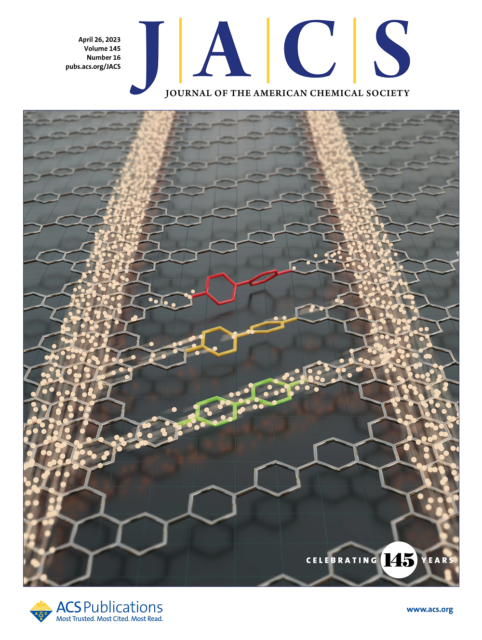Molecular bridges as tools to engineer quantum transport in nanoporous graphene

At the nanoscale, even the most basic quantum size effect, the induction of semiconducting gaps by electron confinement, requires ultimate precision. The case of graphene is a dramatic example, where deviations of a single atom in width can induce dramatic variations of the gap. As a consequence, local defects or variations in width can severely disrupt electron transport properties in nanoscale graphene nanoribbons (GNRs).
Fortunately, the atomic engineering of quantum phenomena in graphene-based nanomaterials started to be a reality a decade ago with the emergence of the bottom-up on-surface synthesis (OSS). In addition to producing atomically precise homogeneous 1D nanostructures, OSS-based methods can also introduce heteroatoms, heterojunctions, or hybrid components in the structure with the same precision, allowing for a precise engineering of the electronic properties. Recently, an OSS synthetic approach based on the lateral coupling of parallel aligned nanoribbons has endowed this atomic engineering capability to the synthesis of two-dimensional nanoarchitectures that can be conceived as nanoporous graphene (NPG). In these intrinsically anisotropic structures, when adjacent ribbons are not equivalent, band mismatch can lead to a total confinement of electrons in individual GNRs.
In contrast, the lateral coupling of equivalent GNRs can lead to sizable interribbon transmission, giving rise to intriguing quantum interferences that regulate the degree of anisotropy of the nanomaterial. Quantum simulations on electron propagation in different proposed NPG nanoarchitectures indicate that the interribbon transmission can be switched on/off by the chemical modification of the coupling bridges.

Now, a team of researchers has synthesised a new NPG structure 1 where such chemical knobs are introduced and where the interribbon coupling strength can be additionally modulated by a continuous conformational transformation of the molecular bridges. The interribbon electronic coupling can be controlled by the different degrees of freedom provided by phenylene bridges that couple the conducting channels. This versatility arises from the multiplicity of phenylene cross-coupling configurations, which provides a robust chemical knob, and from the interphenyl twist angle that acts as a fine-tunable knob.
The capability of manipulating the interphenyl twist angle is experimentally inferred from the subtle interplay between the steric hindrance and substrate interactions that leads to different twist angles in individual ribbons and NPGs with different bridge configurations. This is further corroborated by the researchers using ab initio calculations where the effect of substrate interaction is directly addressed and the energetics of the twist angle are quantitatively analyzed. Electron propagation simulations demonstrate the capability of either switching on/off or modulating the interribbon coupling by the corresponding use of the chemical or the conformational knob.
The synthesis of atomically precise nanoporous graphene structures consisting of graphene nanoribbons connected by flexible phenylene bridges opens a way of tailoring quantum transport and the anisotropy in 2D materials. Calculations demonstrate that para bridges can be designed to tune this anisotropy continuously in a wide range by varying the interphenyl twist angle. This could be modulated by external stimuli such as strain or electric fields applied to functionalized polar phenylene bridges or more statically by using substrates with different degrees of interactions.
Molecular bridges therefore emerge as efficient tools to engineer quantum transport and anisotropy in carbon-based 2D nanoarchitectures. This strategy could also be used to tailor the phononic anisotropy, leading to novel approaches in the search of thermoelectric nanomaterials.
More on the subject:
Topological graphene nanoribbons
Magnetism in graphene nanoribbons induced by a pair of boron atoms
How to synthesize a nanoporous graphene that is both transistor and molecular sieve
Author: César Tomé López is a science writer and the editor of Mapping Ignorance
Disclaimer: Parts of this article may have been copied verbatim or almost verbatim from the referenced research paper/s.
References
- César Moreno, Xabier Diaz de Cerio, Manuel Vilas-Varela, Maria Tenorio, Ane Sarasola, Mads Brandbyge, Diego Peña, Aran Garcia-Lekue, and Aitor Mugarza (2023) Molecular Bridge Engineering for Tuning Quantum Electronic Transport and Anisotropy in Nanoporous Graphene JACS doi: 10.1021/jacs.3c00173 ↩